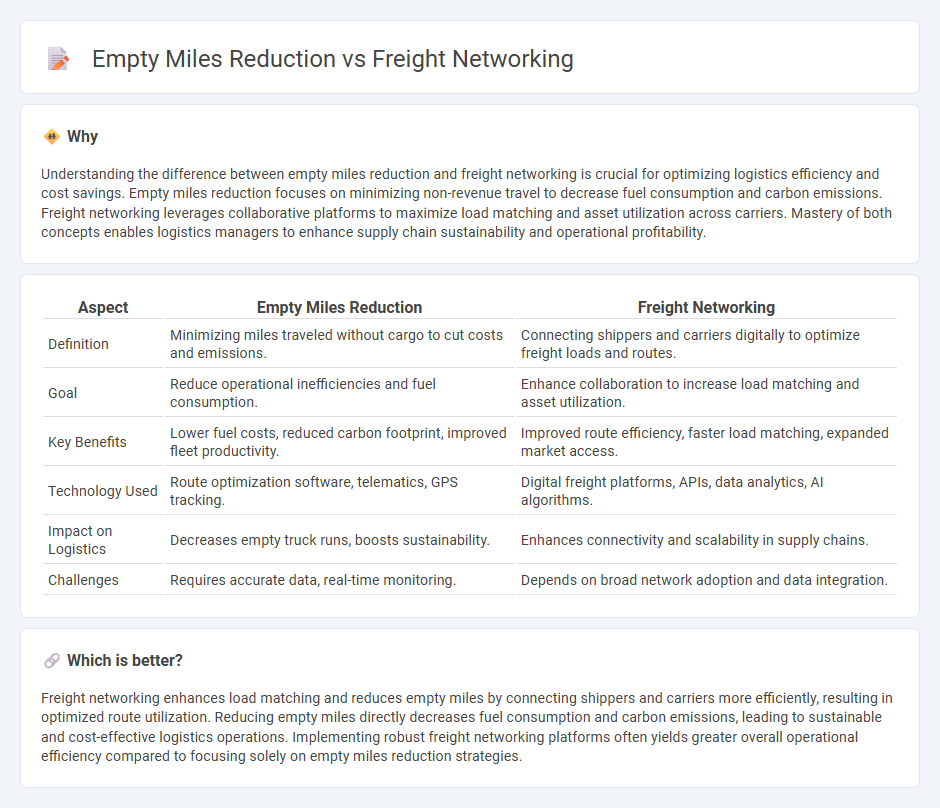
Reducing empty miles plays a crucial role in enhancing logistics efficiency by minimizing fuel consumption and lowering operational costs. Freight networking optimizes load matching across carriers, enabling better asset utilization and reducing the frequency of unladen trips. Explore how integrating empty miles reduction strategies with freight networks can transform supply chain sustainability and profitability.
Why it is important
Understanding the difference between empty miles reduction and freight networking is crucial for optimizing logistics efficiency and cost savings. Empty miles reduction focuses on minimizing non-revenue travel to decrease fuel consumption and carbon emissions. Freight networking leverages collaborative platforms to maximize load matching and asset utilization across carriers. Mastery of both concepts enables logistics managers to enhance supply chain sustainability and operational profitability.
Comparison Table
| Aspect | Empty Miles Reduction | Freight Networking |
|---|---|---|
| Definition | Minimizing miles traveled without cargo to cut costs and emissions. | Connecting shippers and carriers digitally to optimize freight loads and routes. |
| Goal | Reduce operational inefficiencies and fuel consumption. | Enhance collaboration to increase load matching and asset utilization. |
| Key Benefits | Lower fuel costs, reduced carbon footprint, improved fleet productivity. | Improved route efficiency, faster load matching, expanded market access. |
| Technology Used | Route optimization software, telematics, GPS tracking. | Digital freight platforms, APIs, data analytics, AI algorithms. |
| Impact on Logistics | Decreases empty truck runs, boosts sustainability. | Enhances connectivity and scalability in supply chains. |
| Challenges | Requires accurate data, real-time monitoring. | Depends on broad network adoption and data integration. |
Which is better?
Freight networking enhances load matching and reduces empty miles by connecting shippers and carriers more efficiently, resulting in optimized route utilization. Reducing empty miles directly decreases fuel consumption and carbon emissions, leading to sustainable and cost-effective logistics operations. Implementing robust freight networking platforms often yields greater overall operational efficiency compared to focusing solely on empty miles reduction strategies.
Connection
Empty miles reduction directly decreases transportation costs and environmental impact by minimizing unproductive travel distances in logistics operations. Freight networking leverages shared information platforms and collaboration among carriers to optimize load matching, resulting in fewer empty miles. Integrating freight networking strategies enhances route efficiency and resource utilization, driving significant savings and sustainability in supply chain management.
Key Terms
**Freight Networking:**
Freight networking leverages digital platforms and real-time data to connect shippers with carriers, optimizing load matching and reducing inefficiencies across supply chains. By enhancing collaboration among logistics providers, freight networking increases asset utilization and decreases costs associated with underutilized transport capacity. Explore how advanced freight networking solutions can transform your logistics strategy and drive operational excellence.
Load Matching
Freight networking enhances load matching by connecting available cargo with suitable carriers, optimizing route efficiency and reducing empty miles. Efficient load matching algorithms analyze real-time data to minimize unproductive travel, cutting down fuel costs and carbon emissions. Explore how advanced load matching technologies transform freight logistics and maximize operational efficiency.
Carrier Collaboration
Carrier collaboration plays a pivotal role in both freight networking and empty miles reduction by optimizing load matching and route planning, which enhances operational efficiency and reduces costs. Effective communication platforms and shared data enable carriers to minimize empty miles, thereby lowering fuel consumption and environmental impact. Discover how advanced carrier collaboration tools are transforming freight logistics and boosting sustainability.
Source and External Links
World Freight Network - A global network connecting 239 independent freight forwarders across 100 countries for mutual benefit and collaboration.
Pangea Network: Most Reliable Global Freight Logistics Network - An international freight network connecting top air and sea freight specialists, promoting collaboration, shared resources, and streamlined logistics operations worldwide.
Freightnet.com: Freight Quotes | Freight Forwarders and Logistics - A user-friendly platform that connects shippers with a vast global network of over 28,000 freight forwarders and logistics providers to get competitive freight quotes quickly and efficiently.
 dowidth.com
dowidth.com